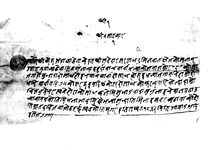A letter from Subedāra Saraṇabhadra Silavāla to a Kerung Aḍḍā official re a boundary dispute (VS 1933)
ID: L_1200_0027
Edited and
translated by Rajendra Shakya
in collaboration with
Rabi Acharya
Created: 2019-01-16;
Last modified: 2020-05-08
For the metadata of the document, click here
The accompanying edition, translation/synopsis and/or commentary are available under the terms of the Creative Commons Attribution-ShareAlike 4.0 International License
Abstract
This letter to a Kerung Aḍḍā official concerns a dispute regarding the demarcation of a boundary between two administrative units.Diplomatic edition
[1r]
1श्री\1श्री५कोसरकार2१[seal with the legend: श्रीफुलचोकी]1स्वस्तिश्रीकेरुअडाकाढेवाकेइतश्रीसुवेदारसरणभद्रसिलवालक्षेत्रृकोसलाम्
2उप्रान्तझगाकाढेवासितमुलाकादहुदापाचपार्वाभन्याकोजगाहाम्रोर¯ १¯ ¯कोसा
3जगाहोमुन्डादादोसाधहोइनपाचपार्वादोसाधहोरुइभन्याजगापनिहाम्रोहो
4भनिपार्वापट्टि७ ॥कोसररुइपट्टि४कोसदोसाधकोफरकपारिवोल्दाहाम्रो
5चित्तवुझेनरस्ववेहोराकोसाधकलेषिसुभाङ∙वाङ्षुनुलाइनेपालपठाउ
6न्याकामभयोतिमिभलाआदमिछौभन्यासुन्दातिमिलाइषवरपठायाकोहो
7तिम्रातदविजमाजोठहर्छस्ववमोजिमगरइतिसम्वत्१९३२मितिआषाडशुदि
8३रोज७शुभ्म्¯¯¯ ¯¯¯ ¯¯¯ ¯¯¯ ¯¯¯ ¯¯¯ ¯¯¯ ¯¯¯
Translation
[1r]
Śrī 5 Sarkāra – 1
[Seal with the inscription ‘śrī phulacokī’]
Hail! To the ḍhevā1 of the Śrī Kerung (text: Keru) Aḍḍā
Salutations from here (ita) from ŚrīSubedāraŚaraṇabhadra Silavāla Kṣetrī (text: Saraṇabhadra Silavāla Kṣetṛ)
Uprānta: During a meeting with the ḍhevā of Jhugā (text: Jhagā)2 , [he claimed that] “the land called Pācapārvā3 is land shared4 : [it is] ours and Śrī 5 Sarakāra['s]5 Munḍāḍā6 is not the boundary; Pācapārvā is the boundary. The land called Rui[bhoṭ] also belongs to us," and in [so] speaking effectively changed the boundary: 7 and a half kośas in the direction of [Pāca]pārvā and 4 kośas in that of Rui[bhoṭ]. We did not go along with this, and wrote a sādhaka with the above-mentioned details and sent subbāṄavāṅa Khunu [along with the sādhaka] to Nepal.
As we have heard that you are a bhalādamī, we have sent this information to you. Do what you deem right.
Saturday, the 3rd of the bright fortnight of Āṣāḍha in the [Vikrama] era year 1932 (1876 CE). Auspiciousness.
Commentary
This letter is addressed to an unnamed officer (ḍhevā) of the Kerung Aḍḍā, who is immediately greeted by Subedāra Śaraṇabhadra Silavāla Kṣetrī, presumably the person who wrote it. It would have been unusual for an army officer in charge of a district to greet a low-ranking functionary there, which suggests that a ḍhevā may have been someone high in rank. The writer tells the ḍhevā of Kerung to do what he deems right over a dispute regarding the demarcation of a boundary, having been unhappy with where the ḍhevā of Jhugā said the line ran.
The letter mentions that the subbā was sent to Nepal (i.e. the Kathmandu Valley) bearing a sādhaka, which suggests that a higher authority in the centre was expected to act on the matter.

